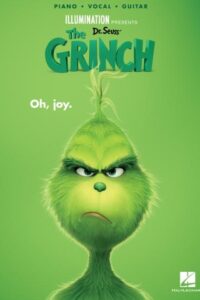Come join us now, and enjoy playing your beloved music and browse through great scores of every level and styles!
Can’t find the songbook you’re looking for? Please, email us at: sheetmusiclibrarypdf@gmail.com We’d like to help you!
Table of Contents
Dr Seuss’ The Grinch – Piano Vocal Guitar Chords

Search your favorite sheet music in the Sheet Music Catalog

Please, subscribe to our Library.
If you are already a subscriber, please, check our NEW SCORES’ page every month for new sheet music. THANK YOU!
More Than a Grouch: The Enduring Magic of Dr. Seuss and The Grinch
High on Mount Crumpit, just north of the perpetually cheerful Whoville, lives a solitary, green-furred creature with a heart “two sizes too small.” For over six decades, the Grinch has been a staple of the holiday season, his name synonymous with festive cynicism. But the story of How the Grinch Stole Christmas! is far more than a tale of a grumpy outcast; it is the brilliant, enduring creation of a literary genius, Dr. Seuss, and a poignant exploration of the true meaning of community and joy.

Browse in the Library:
Or browse in the categories menus & download the Library Catalog PDF:
The Man Behind the Cat: Dr. Seuss
Before the Grinch ever devised his “wonderful, awful idea,” there was Theodor Seuss Geisel. A man of boundless imagination and a playful rebellion against the dull “Dick and Jane” primers of his era, Geisel, under his pen name Dr. Seuss, revolutionized children’s literature. His books were a riot of rhythmic anapestic meter, nonsensical words (“Zizzer-Zazzer-Zuzz”), and bizarre, beautiful creatures drawn in his unmistakable style.
But beneath the whimsy lay a profound seriousness. Seuss wasn’t just entertaining children; he was speaking to them about complex issues—environmentalism in The Lorax, the Cold War in The Butter Battle Book, and prejudice in The Sneetches. His work trusted children to understand nuance, to grapple with big ideas, and to see the world through a more imaginative and compassionate lens. He created entire worlds to hold a mirror to our own, and Whoville was one of his most enduring creations.

The Grinch: A Story Born of Frustration
The genesis of How the Grinch Stole Christmas! in 1957 is now legendary folklore. Facing a deadline and growing increasingly annoyed by the commercialized frenzy of the season, Seuss looked in the mirror and reportedly muttered, “I’m just a sour Santa.” He saw his own grumpiness reflected back and wondered what would happen if someone tried to steal Christmas itself.
The result was a masterpiece of economy and emotion. The Grinch isn’t a villain in the traditional sense; he is a character defined by pain. His isolation is palpable, his cynicism a shield for a heart that has been wounded. He mistakes the Whos’ boisterous, material celebration for the source of their joy, leading him to believe that by stealing their “roast beast” and “tinsel and trimmings,” he can silence their song.

The Heart of the Matter: Why the Story Endures
The power of the Grinch’s story lies in its stunningly simple climax. As the sun rises on Christmas Day, expecting to hear the Whos’ cries of disappointment, the Grinch is confounded. Instead, they are standing hand-in-hand, singing a joyful song. At that moment, he has a life-altering epiphany:
“Maybe Christmas,” he thought, “doesn’t come from a store. Maybe Christmas… perhaps… means a little bit more!”
This revelation is the story’s beating heart. It’s a message that transcends religion and culture: that true joy is found in community, love, and shared spirit, not in material possessions. The Grinch’s heart doesn’t just grow; it heals. By being welcomed into the very community he sought to destroy, he experiences the redemption he never knew he needed.
From Page to Screen: A Legacy in Motion
The Grinch’s journey didn’t end with the book. Chuck Jones’s 1966 animated television special, with its iconic voice performance by Boris Karloff and the unforgettable song “You’re a Mean One, Mr. Grinch,” cemented the story in the cultural firmament. It masterfully expanded Seuss’s world while staying true to its soul.
Later adaptations, from the live-action film starring Jim Carrey (2000) to the more recent Illumination animated version (2018), have reinterpreted the character for new generations. Each version explores the Grinch’s backstory and loneliness in different ways, but they all orbit the same, unchanging core—the transformative power of kindness and the idea that no one is beyond redemption.

A Timeless Lesson for All
Dr. Seuss’s The Grinch endures because it speaks to the “Grinch” and the “Who” in all of us. We all have moments of feeling outside the circle, of being exasperated by festive obligations, or of confusing happiness with having. And we all have the capacity for the Whos’ profound, inclusive grace.
Every time we watch or read the story, we are reminded that a community’s strength is measured not by its presents, but by its presence. We are reminded that even the most closed-off heart can be opened with a simple act of understanding. In the end, Dr. Seuss gave us more than a holiday classic; he gave us a timeless fable about the unsealable nature of love, and for that, our own hearts grow three sizes every year.

Search your favorite sheet music in the Sheet Music Catalog
You’re A Mean One, Mr. Grinch (The Grinch)
You’re A Mean One, Mr. Grinch · Tyler, The Creator Dr. Seuss’ The Grinch (Original Motion Picture Soundtrack).
